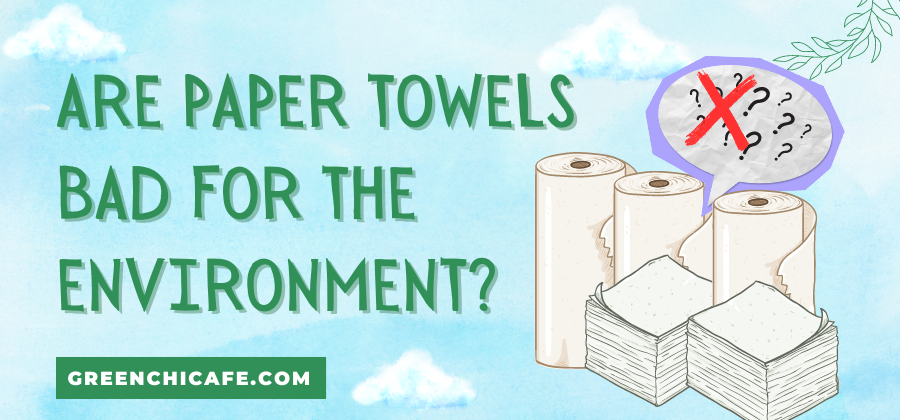Paper towels generate waste and rely on tree fiber, but their overall impact depends on factors like recycling and responsible manufacturing.
Individual paper towels have a small carbon footprint.
But widespread use contributes to deforestation, pollution from transportation and manufacturing, and landfill methane emissions.
Are Paper Towels Bad for the Environment?

Paper towels have some negative environmental impacts from resource use, manufacturing processes, and waste.
But recycled content, efficient consumption, and proper disposal can greatly reduce their footprint.
Overall, while not the most eco-friendly choice, paper towels’ detriments can be mitigated through conscientious production and use.
Key Points
- Recycled fiber paper towels have about half the carbon footprint of virgin pulp towels.
- Responsible forestry and manufacturing practices lower impacts.
- Reducing use and recycling after use minimizes towel waste accumulation.
How Does Paper Towel Production Impact the Environment?
Conventional paper towels source pulp from tree logging, which can contribute to deforestation and habitat loss.
Producing and transporting paper towels also uses energy and creates pollution.
However, towels containing recycled content reduce these impacts.
And sustainable forestry and manufacturing practices can lower the carbon footprint of virgin fiber towels.
Do Recycled Paper Towels Help the Environment?
Yes, recycled paper towels consume less water, energy, and trees compared to towels made solely from virgin wood pulp.
Recycling gives waste paper and cardboard a new purpose rather than sending them to landfills.
Recycled fiber towels have around half the carbon footprint of conventional virgin paper towels.
Eco-conscious consumers should seek high recycled content when buying paper towels.
How Does the Use of Paper Towels Lead to More Waste?
Many paper towels end up in landfills after limited use.
Frequent disposal leads to waste accumulation, consuming resources required for manufacturing.
Recycling used paper towels helps prevent landfill additions.
However, reduced consumption through eliminating unnecessary use and embracing reusable cleaning cloths limits towel waste at the source.
Responsible usage and disposal habits make the biggest difference in minimizing towels’ environmental impact.
Do Paper Towels Breakdown in Landfills?
Paper towels take around a month to decompose in landfill conditions – longer if the towels contain recycled plastic content.
Deprived of light and oxygen, towels break down slowly while producing methane gas emissions.
Composting facilities provide better conditions for quicker paper towel decomposition.
But keeping towels out of landfills through recycling, composting, and reducing use remains the most eco-friendly option.
How Does the Manufacturing Process Impact the Environment?
Producing paper towels requires significant water and energy for forestry, pulping, papermaking, and transportation.
The U.S. EPA estimates manufacturing one ton of virgin paper uses 26,500 gallons of water.
Responsible forestry practices like protecting waterways and sustaining biodiversity reduce impacts.
Some manufacturers utilize renewable energy and recycle water during production to lower their environmental footprint.
Do Paper Towels Contribute to Deforestation and Global Warming?
At large scale, the high global demand for paper towels does drive logging and land conversion for wood pulp production resulting in deforestation, habitat loss, and emissions fueling climate change.
However, purchasing recycled content towels, using paper towels efficiently, and recycling after use mitigate these impacts.
Thoughtful consumer choices and manufacturing improvements can limit paper towels’ detrimental effects.
Additional energy and emissions for collection and reprocessing.
Transportation for forestry, production, and consumer use emits greenhouse gases.
Chemical bleaching and manufacturing pollute air and waterways.
Instead of paper towels, reusable cleaning cloths greatly reduce waste and environmental harm.
Overall, curbing paper towel usage in favor of more sustainable alternatives benefits ecosystems.
Which is Better for the Environment Paper Towels or Cloth Towels?
Cloth towels are better for the environment than paper towels.
Reusables avoid waste and eliminate the continual resource demands of disposable paper towels.
Washing cloths uses less water than manufacturing new paper towels.
However, paper towels can be recycled and made sustainably.
But cloth towels provide the lowest-impact cleaning solution through repeated use and laundering.
Choosing eco-friendly paper towels, using them sparingly, and recycling them after use help reduce their detrimental effects when needed.
Do Paper Towels Break Down in Landfills?

Yes, paper towels do gradually break down in landfills but the process takes considerable time – around one month for a single towel to decompose.
Deprived of light, oxygen, and moisture, landfill conditions significantly slow paper towel biodegradation.
Meanwhile, landfills become over-packed with accumulated paper waste and release methane emissions as materials gradually decay.
Composting used paper towels accelerates decomposition and avoids landfill accumulation.
But reducing usage and recycling towels provide more eco-friendly solutions.
Key Takeaways:
- While not the most eco-friendly option, paper towels’ net environmental impact can be reduced through efficient use, recycling, purchasing recycled and sustainably sourced options, and avoiding waste.
- Ethical manufacturing, government regulations, and consumer awareness enable further progress in minimizing paper towels’ footprint.
FAQ
What is the Carbon Footprint of a Paper Towel?
One paper towel has an estimated carbon footprint of around 20 grams of CO2 is made from 100% recycled content. Virgin pulp towels produce double the emissions. But multiplied by billions of towels used, impacts accumulate.
How Long Does it Take Paper Towels to Decompose?
In landfill conditions, paper towels can take around one month to decompose because of limited light and oxygen. In compost piles with moisture and airflow, decomposition occurs more rapidly in 2-4 weeks.
What is an Eco-Friendly Alternative to Paper Towels?
Reusable cleaning cloths like microfiber, cotton, and bamboo provide a sustainable alternative to eliminating disposable paper waste. Washable silicone scrubbers and sponges also minimize environmental impact.
Do Paper Towels Come From Sustainable Sources?
Some brands use forest certification programs to ensure sustainability. Seeking towels with recycled content further reduces tree harvests. But overall consumption still pressures limited resources.
At GreenChiCafe, we are passionate about protecting the natural world and sharing knowledge that cultivates more sustainable lifestyles.
Please check out our website for more content about caring for our planet and living eco-consciously.
